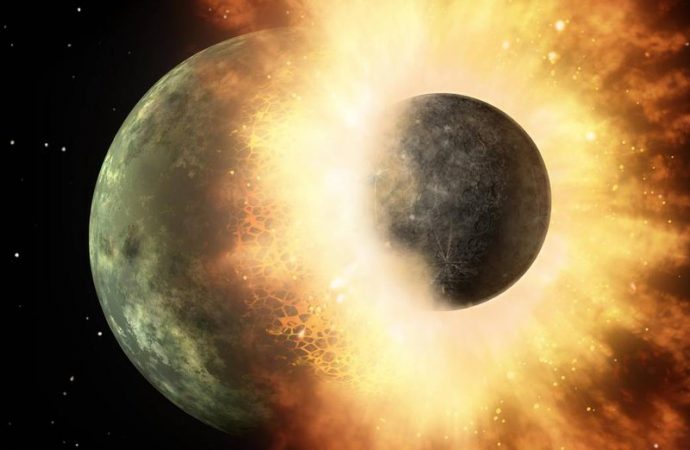Like a boisterous older sibling, the gas giant both beat up and protected young Earth
Big siblings aren’t always the gentlest with their little brothers and sisters. But a little tough love early on might prepare you survive to adulthood—at least that’s what researchers are finding when it comes to our solar system, where Jupiter may have ultimately ensured a safe future for Earth and other rocky worlds by playing the role of boisterous big brother.
“Previous theories said that Jupiter was a friend of the Earth, because it shielded Earth from all of these late impacts,” says Elisa Quintana, a research scientist at NASA Ames Research Center. “We’re finding that’s not necessarily the case, at least not for our solar system.”
While Jupiter is protective today, in the past it may have played a little more energetically. Early on the gas giant was a tyrant, hurling debris toward the inner solar system when Earth was still forming. But in the long-term its rough-and-tumble approach proved beneficial: All of those collisions sped up the construction of rocky worlds and prevented worse collisions from happening later on, as they did for rocky planets without neighboring giants.
Quintana worked with senior research scientist Thomas Barclay, also of NASA Ames, to model how multiple planetary systems fared with and without massive gas worlds. For rocky worlds like ours, they found that Jupiter-like gas giants played a more complicated role than previously thought. Barclay presented the pair’s results last month at the 228th meeting of the American Astronomical Society in San Diego, California; part of their ongoing research was also published in the Astrophysical Journal this April.
Jupiter-sized worlds can have seemingly disparate effects on the planets around them. For instance, the gravity of gas giants not only pulls material toward them, but can also send it hurling away at faster speeds. When it comes to building planets, that can actually be a good thing. Quintana found that a young Jupiter sent material flying into the cores of growing rocky planets, which helped them grow faster than those without large neighbors.
Gas giants also affect how many rocky planets can form. That’s because, like an older sibling, they tend to hog all the toys—in this case, the dust and gas needed for building planets. The researchers found that Jupiter-sized worlds usually had just 3 to 6 terrestrial neighbors, while systems with no giant planet built twice as many rocky worlds in the inner and outer regions.
In the no-Jupiter scenario, there was no gas giant to gobble up gas and dust, meaning that this debris formed what Quintana calls a “shroud, sort of like a cloud of small rocky material.” The debris stuck around for more than 2 billion years, pelting the remaining terrestrial worlds with constant impacts. The collisions weren’t large enough to strip planets of their crust but, much like the asteroid that helped to wipe out the dinosaurs, they had the potential to obliterate some of the life on the planet.
When Jupiter was present, by contrast, the dangerous debris cloud vanished in a tenth of the time. Gas giants sent material hurtling off into space at high speeds, casting some of it completely out of the solar system. That didn’t mean planets were out of the woods yet: At the same time, giant worlds also flung debris inward toward the rocky planets, traveling faster than the material in the Jupiter-free collections.
The faster flying objects meant more powerful collisions—we’re talking collisions strong enough to strip a world of its oceans and atmospheres, sterilize the surface, and destroy any life that might have evolved. Each rocky world received 3 to 4 of these brutal impacts throughout its lifetime, But they happened early enough that the world could recover. Terrestrial planets with massive neighbors felt the last of their surface-destroying collisions after 200 million years—an eye-blink in Earth’s 4.5-billion year lifetime.
Early impacts give a planet time to resupply its oceans and atmosphere from the cloud of gas before Jupiter tossed it out of the system. The simulations showed that the last major crash occurred at about 50 million years for most terrestrial planets with giant friends, time enough to gather more material from this disk. This lines up with estimates that place Earth’s moon-forming collision between 30 and 110 million years.
For Earth, Jupiter certainly played a welcome role, helping the planet and its rocky neighbors grow rapidly while shielding it from the most violent attacks while early life evolved. Now scientists are trying to figure out what that means when it comes to looking for other habitable worlds. If a Jupiter-sized world can keep their rocky counterparts, should we be looking for rocky systems with a gas giant at the outer edges?
“It seems like the quiet period of the solar system is longer if there’s Jupiter-sized planets,” says Jessie Christiansen, an exoplanet hunter at the California Institute of Technology who was not part of the research. That quiet period is “the restful period where you can let things evolve on Earth, like life, without being constantly wiped out,” she says.
In the hunt for potentially habitable planets, it might not be a bad idea to keep an eye on rocky worlds with distant giant friends, she adds. Unfortunately, that could mean bad news for life in the universe: less than 10 percent of sun-like stars have gas giants in their outer orbits. “We don’t think that Jupiter-analogues are common,” Quintana says.
Source: Smithsonian Mag

































Leave a Comment
You must be logged in to post a comment.